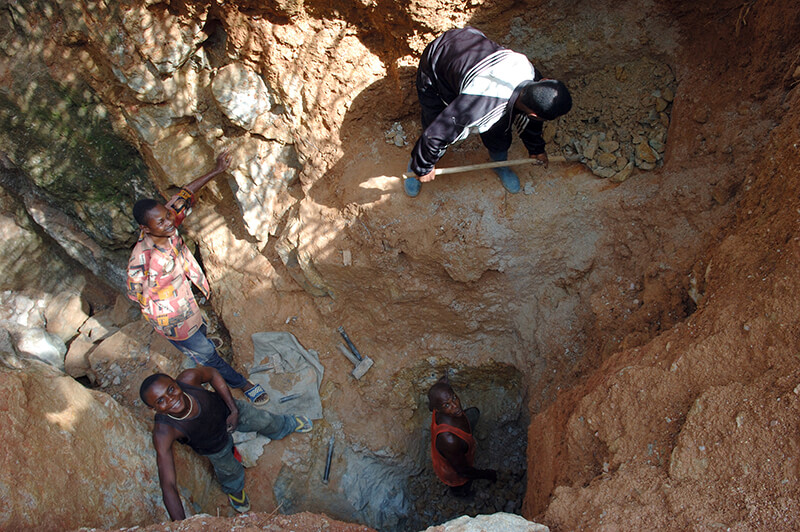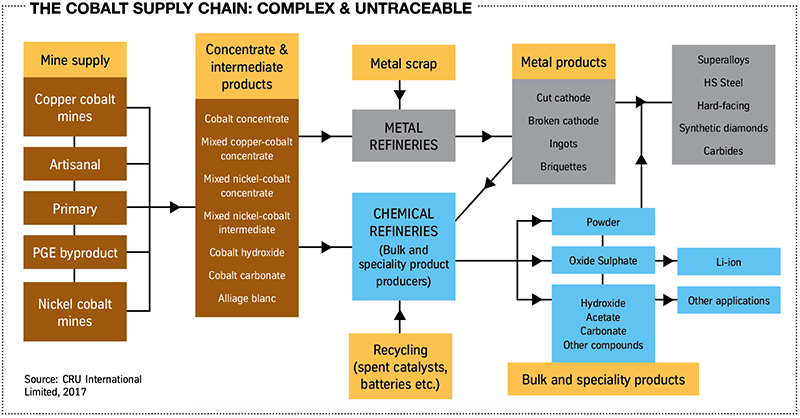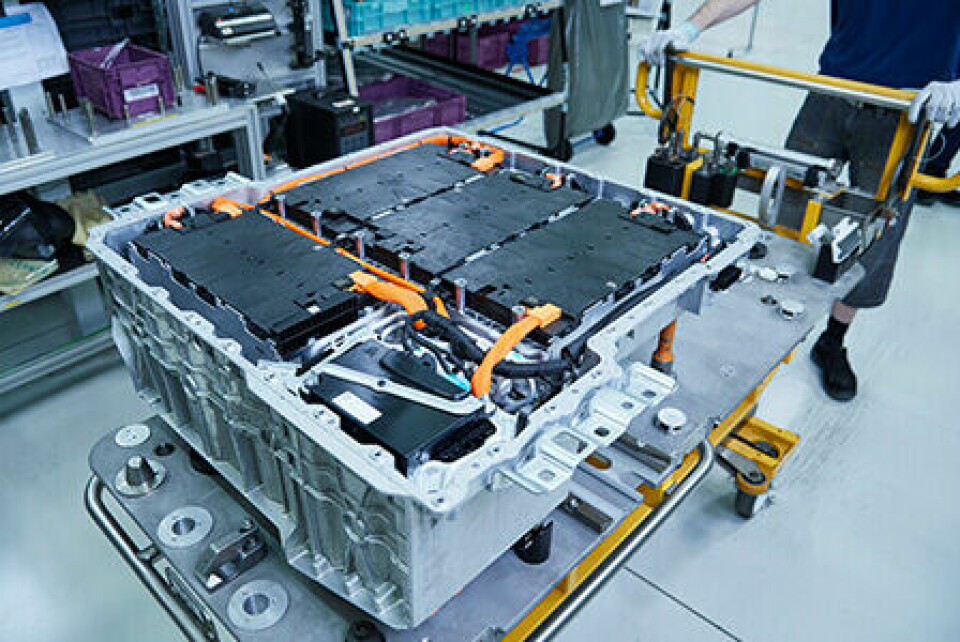The ethics of sourcing for electrics
 As the march towards mass-market take-up of electric vehicles continues, there is a growing focus on the sustainability of the raw materials used in the EV and battery supply chain, such as copper, nickel, cobalt and lithium.
As the march towards mass-market take-up of electric vehicles continues, there is a growing focus on the sustainability of the raw materials used in the EV and battery supply chain, such as copper, nickel, cobalt and lithium.
Generally speaking, the social and environmental impacts of raw material production will depend on the nature of the material itself, along with the social, political and economic conditions under which it is extracted. However, Leah Butler, vice-president of the Responsible Business Alliance – an industry body comprised of electronics, retail, automotive and toy companies – and its offshoot the Responsible Minerals Initiative (RMI), says the risks associated with nickel, cobalt, copper and lithium mineral supply chains, in particular, are very varied. These range from water and soil pollution, biodiversity threats, high CO2 emissions and health and safety issues to the use of toxic chemicals, conflict with local communities, issues related to artisanal and small-scale mining, and child or forced labour.
According to Stefan Sabo-Walsh, director of commodities research at global risk analytics and forecasting company Verisk Maplecroft, nickel and lithium in particular – both of which are crucial in the production of lithium-ion batteries – score poorly in the company’s raw material environmental assessment. Copper production, meanwhile, has been linked to political instability and corruption in a number of key producing countries, he says: in Peru, for example, the copper mining industry remains “a focal point for social unrest”, while in Chile, protest activity has also occurred around copper mines. Allegations of corruption have also been levelled against the copper industry in places such as China, Peru and the Democratic Republic of the Congo (DRC).
While some cobalt production in the DRC is undertaken by a number of large-scale mining operations, Sabo-Walsh confirms that artisanal cobalt mines remain common in key production regions there, including Katanga. Alongside what he terms the “poorly enforced labour laws and multitude of human rights violations” – including the use of widespread child labour at artisanal mines – he says there are also “major” health and safety issues right across the sector.
Despite this stark assessment, George Heppel, a consultant for cobalt and molybdenum at commodities consultancy CRU Group, says supply chains for copper and nickel are relatively well-established and that EVs form only a small part of what is a very large market.
 “I wouldn’t suggest that obtaining copper or nickel for EV batteries in particular would have any major social or environmental impacts; likewise for lithium,” he states.
“I wouldn’t suggest that obtaining copper or nickel for EV batteries in particular would have any major social or environmental impacts; likewise for lithium,” he states.
That said, he agrees that cobalt extraction is of significant social impact – not least as around 60% of global supply is mined from the DRC, a large part of which comes from artisanal mining sources. The vast majority of this cobalt, says Heppel, is shipped to China for processing into battery chemicals, meaning this country now controls most of the world’s cobalt chemical market, a situation he describes as of “particular concern to traditional battery and auto firms in Japan and South Korea”.
A recent sharp hike in cobalt prices has done nothing to improve conditions in the industry, either. “Increased demand for cobalt from the battery industry has caused the price of cobalt to skyrocket over the past couple of years, and there are real concerns about potential shortages in the years to come as supply cannot keep up with demand in the long run,” Heppel comments.
Seeing the problemIn attempting to mitigate the negative impacts of sourcing such raw materials, says Sabo-Walsh, companies face multiple challenges relating to supply chain traceability.
The main problem is finding out if the metals used in their products come from responsibly or irresponsibly managed operations – whether industrial or artisanal – as they lack visibility over the lower levels of their supply chain.
“This leaves them exposed to the potential for their products to contain minerals mined by workers in extremely hazardous conditions or [that are] linked to widespread pollution,” he says.
Butler agrees that assessing the social and environmental risks in raw materials extraction and processing, and appropriately managing such risks, remains a challenge for downstream companies due to the size and complexity of international supply chains, with suppliers beyond the first tier often hard to trace.
Moreover, she explains, suppliers further upstream may not be familiar with responsible sourcing expectations and can therefore have limited knowledge when it comes to responding to customer requests on this score.
 “Small to medium-sized suppliers may also have limited financial or human resources to dedicate to meeting survey or reporting requirements,” she says. “All combined, this results in a need for ongoing communication of supply chain expectations coupled with awareness-raising, capacity-building, and deployment of technical and training resources for upstream partners.”
“Small to medium-sized suppliers may also have limited financial or human resources to dedicate to meeting survey or reporting requirements,” she says. “All combined, this results in a need for ongoing communication of supply chain expectations coupled with awareness-raising, capacity-building, and deployment of technical and training resources for upstream partners.”
Strategic initiativesIn responding to these challenges, Heppel says, most technology and automotive firms try to sign long-term agreements with legitimate mines in order to avoid buying materials like cobalt on the open market and thereby avoid exposing themselves to the potential risk of dealing with unethically-sourced materials.
Signing such deals obviously also secures a more stable supply, which is of benefit with materials like cobalt. “This has the additional benefit of removing the possibility of supply risk, as the cobalt market is expected to suffer heavy shortages in coming years as demand for EVs grows exponentially,” says Heppel. “The other alternative, as an auto company, would be to invest in a cobalt-producing mine. There are rumours circulating that Tesla is apparently looking into investment in North American cobalt projects, for example, but we haven’t heard any confirmed reports of this yet.”
Sabo-Walsh says there is a “small but growing” number of partnerships and initiatives in place to help address concerns around raw materials sourcing for the production of EVs.
These include the Responsible Cobalt Initiative, which focuses on environmental, social and governance (ESG) concerns related to the production of the raw material, and the Responsible Business Alliance, which promotes a joint approach to addressing ESG issues across supply chains. Members include multinational electronics and automotive companies, which share information on their supply chains in order to collaboratively address issues around supply chain traceability.
“Businesses also continue to search for solutions that will help them gain transparency over their extended supply chains to mitigate exposure to ESG issues. While a number of emerging technologies – including blockchain – have the potential to support businesses in this endeavour, even those companies with fully mapped supply chains, like those in the tech sector, have found themselves exposed to a myriad of issues across them,” he says.
 Butler confirms that RMI members, who include car manufacturers, have taken a collaborative industry approach to addressing these supply chain challenges. Working together and across industries, she believes that companies can drive broad-based improvements in supply chains in a coordinated and collective manner.
Butler confirms that RMI members, who include car manufacturers, have taken a collaborative industry approach to addressing these supply chain challenges. Working together and across industries, she believes that companies can drive broad-based improvements in supply chains in a coordinated and collective manner.
“Through the RMI, automotive companies drive the development and international uptake of a range of tools and resources that promote supply chain due diligence at all levels, not just for tier one suppliers,” she says. “This includes encouraging metal processors like smelters and refiners to undergo independent third-party audits, and providing resources for their success; using harmonised and internationally accepted surveying tools, such as the Conflict Minerals Reporting Template; and contributing to peer learning via publication of guidance documents and white papers, and influencing international dialogue.”
Butler confirms that the RMI is also actively supporting companies’ efforts to identify and prioritise the salient social, environmental and governance impacts of extraction and processing of raw materials in international supply chains. To this end, it has launched new tools and resources that help companies to exercise due diligence, including the Risk Readiness Assessment (RRA) Platform, a self-assessment tool for companies along the value chain to assess and communicate their risk management practices across 31 areas. This, she says, “promotes a common understanding of best practices and a means to consistently assess risks in the mineral supply chain”.
“We are pleased that more than 60 downstream and 153 upstream companies are active on the RRA Platform to date. Additionally, in March 2018, the RMI, in coordination with DRIVE Sustainability and The Dragonfly Initiative, will publish material risk profiles for 17 raw materials commonly used in automotive and electronic products as well as a risk matrix covering 45 raw materials,” says Butler.
The DRIVE Sustainability initiative, a partnership of ten major automotive brands, has also recently established a Raw Materials Observatory to identify ethical, environmental, human rights, labour rights and environmental issues in the sourcing of raw materials.
 As Stefan Crets, executive director at corporate social responsibility business network CSR Europe, explains, the aim is to assess the sustainability risk of the top raw materials for the automotive sector and identify potentially impactful activities that might address these risks.
As Stefan Crets, executive director at corporate social responsibility business network CSR Europe, explains, the aim is to assess the sustainability risk of the top raw materials for the automotive sector and identify potentially impactful activities that might address these risks.
“Collective action will complement what automotive companies are doing at company level to integrate sustainability in the sourcing of raw materials,” he says. “At this stage we are focusing on the mapping of risks and issues – this is the purpose of the Raw Materials Observatory. Once this has been accomplished, we will discuss the specific viable options to address them, as each material or supply chain is specific and has its own challenges.”
Call for collaborationLooking ahead, Heppel confirms that most of the major battery manufacturers are currently trying to reduce the amount of cobalt used in their products in favour of more nickel. This, he says, could alleviate pressure on the cobalt market but cause additional pressure on the high-grade nickel market, as most of the nickel currently extracted is low-quality material designed for the steel industry.
As demand for electric vehicles spikes, meanwhile, Sabo-Walsh suggests that EV manufacturers will have to cast an ever-wider net to source the raw materials they need.
A standard EV consists of more than 30,000 individual components, which makes for a hugely complex supply chain, he stresses. And each raw material has a unique ESG profile, meaning that simply substituting raw materials may result in replacing one risk with another.
In order to help avoid such uncoordinated efforts, Crets argues, more cross-sector alignment and collaboration are now necessary.
“New materials mean more due diligence and transparency is needed and this cannot be pursued by a single company alone. There is also a role for government to create incentives and to work on educating sourcing countries,” he says.
However, until such coordination and collaboration are achieved and start to pay off in terms of tangible improvements in the social and environmental conditions under which some raw materials are extracted, it looks like the questions over the true sustainability of EVs will only get louder.
As well as acting collectively through organisations like the RMI and Global Battery Alliance, some companies are also pursuing individual strategies aimed at ensuring the sustainability of their raw materials. One example is BMW, which recently established a Responsible Copper Initiative with the Chilean state-owned copper mining company Codelco.
BMW has also participated in the Responsible Cobalt Initiative and late last year committed to improving transparency in its battery cell supply chain by releasing information on smelters and countries of origin for raw materials, as well as to producing a feasibility study on potential model mines in the DRC to help improve the social and ecological situation there.
Speaking in November last year, Ursula Mathar, head of sustainability and environmental protection at BMW, said: “The BMW group does not procure any cobalt itself; it only comes into contact with this raw material through the purchase of battery cells, for example. However, we are well aware that growing demand for electric vehicles also goes hand-in-hand with a responsibility for the extraction of relevant raw materials, such as cobalt.
“As a premium manufacturer – and in the interests of our customers – we aim to establish a transparent and sustainable supply chain that meets the highest standards.”
Another OEM seeking to make a difference is Mercedes-Benz, which has announced its intention to electrify its entire portfolio in every segment by 2022.
As a spokeswoman for Mercedes-Benz Cars explains, many of the materials contained in batteries are not procured directly by Daimler, but via complex supply chains involving many sub-suppliers, meaning it is sometimes difficult to verify their origin.
[related_topics align="right" border="yes"]Mercedes-Benz is, however, conscious of its responsibility to ensure sustainable production with outsourced parts, she says.
“For many years already, we have defined in our Supplier Sustainability Standards the sustainability requirements our suppliers must meet. Major components of these standards are requirements relating to working conditions and respect for human rights. In recent years, we have intensified and systematically increased our efforts to ensure a sustainable supply chain. Child labour is explicitly forbidden in the Mercedes-Benz contract terms with suppliers. In this respect, we take our reference from the ILO standards,” she says.
The company is in a position to exert most influence with its direct contractors and has introduced a suppliers’ pledge to impose and verify its sustainability standards within the supply chain, the spokeswoman adds.
“We further make intensive efforts to create transparency in complex supply chains. For instance, in the paint supply chain we have uncovered deficits, evaluated them and taken appropriate measures, including the dissolution of supply contracts. We are extending this transparency to other raw material chains. At present, we are also conducting this analysis for cobalt and rubber,” she says.
Mercedes-Benz assesses the raw material requirements for its vehicles in the early phase of their development, before suppliers are even selected, using a comprehensive approach based on criteria developed alongside industry and science partners as part of the ESSENZ research project, says the spokeswoman.
Risk assessments, according to the ESSENZ approach, show how critical the use of a particular raw material is, or can become, with focus on three dimensions: geological availability and the economic and social risks. Meanwhile, for the phase preceding contract placement and during continuing business activity, the company is currently developing and piloting a multi-stage system to monitor its suppliers.
“The system will include intensive research, surveys and monitoring measures on a risk-oriented basis. Furthermore, we are seeking to create transparency in critical areas of the supply chain, [like] smelting plants and mines,” says the Mercedes-Benz spokeswoman.







